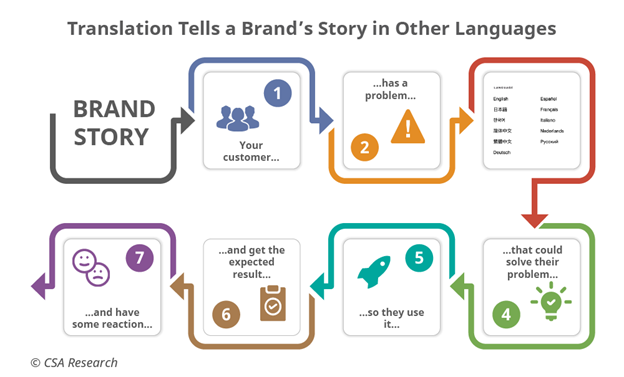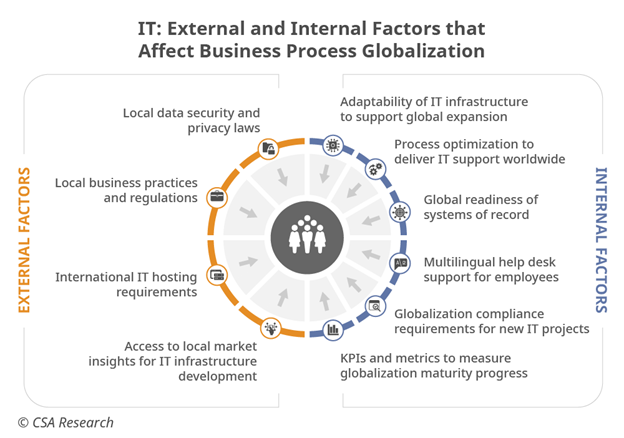We sincerely thank Don DePalma for elaborating on his inspiring talk in two blog posts!
Earlier this year I had the pleasure of speaking at Brainfood, Eurocom's and Kaleidoscope's internal conference for sharing ideas and imagining the future. Rather than setting an agenda for discussion with my keynote, CEO Anita Wilson gave me the task of concluding the conference after two days of active discussion. In my address, I rethought the reason for the translation business, provided guidance that I call the Prime Directive for that activity, and reviewed the implications of that mandate for humans and technology. Here's a recap of what I presented.
Why Translate and Localize?
Why would you or I translate something? The answer that should be obvious to almost everyone reading this is because not everybody speaks your – or my – language. Simply stated, the purpose of translation is to meet a fundamental market demand to communicate a brand, organization, or government agency's „story" as they engage with markets where the audience speaks other languages. Figure 1 shows one such story – a customer support problem. Every organization has multiple stories, each curating a user's path through a marketing, sales, investment, support, or other experience.

Figure 1: Translation Tells a Brand's Story in Other Languages
Translation helps deliver a metaphorical journey that meets the customer or user expectations of each organization. These localized communication and business functions can inspire confidence in the brand, safeguard security and privacy, and do so in a way that is relevant to each visitor's language, economy, and culture. To succeed internationally anyone operating in international or domestic multicultural markets must do this for multiple people, across many business functions, every day, adapting to changes and innovations.
The problem that I see every day is that people in the language business sometimes lose sight of what they do for a living. Why? Business realities distract them from a laser focus on their mission while procurement departments or executives require in-house localization teams and their language service providers to get the lowest cost per word, use domestic market measures to demonstrate the return on investment of global initiatives, and optimize the cost of everything they do. And then optimize it yet again in a form of Xeno's Paradox that means they'll never achieve the goal of a perfect machine with no waste, downtime, or unexpected costs.
The Prime Directive of Localization
To keep from losing that clarity regarding the purpose of translation, I invoke the Prime Directive, a concept that should be familiar to sci-fi fans of a certain age. When Star Trek launched in 1966, its Prime Directive stated that starships should not interfere with the societies they encountered. That enlightened goal was meant to avoid the negative effects of eighteenth-century colonialism on indigenous Earth peoples. This concept flows naturally to translation and the broader topic of localization:
The Prime Directive for Localization prohibits any organization operating in international, multicultural, or multilingual environments from requiring the use of or adherence to its own language, payment system or currency, cultural assumptions, and other aspects of life. Failure to localize to each market's requirements is punishable by loss of business, inferior brand equity, higher costs for support, and competitive disadvantage.
The Prime Directive of Localization incorporates those very necessary business discussions and calculations but in the context of a fundamental mission to boldly ensure that the interaction or transaction meets the requirements of the situation and does not cause any negative business consequences. And to do this across whatever kinds of experience you might want to offer – whether it be for a customer, user, employee, citizen, immigrant, or extraterrestrial being – at each stage of a relationship. Doing it well forms a foundation for customer trust and brand integrity, with needed security and privacy, all with the perception and delivery of quality – that is, good translation and localization delivers a good experience, and thus a positive perception of the brand.
How Do You Deliver on the Prime Directive?
That mission means using the right language, the right time zones, the right currency – in other words, the right choice for that geography, and ideally for that individual, across all aspects of the particular use case and for every interaction an organization supports.
Given the strategic importance of customer and user experiences to your companies, the translation of the content and localization of those experiences elevates those functions to the same level as other business-critical systems. What that means is the software used to provide these functions – translation memory, terminology, translation management, machine translation, quality evaluation – all become part of a technology stack that an organization relies on to carry out the normal business operations that keep the business running successfully. They can't be lightweight solutions but instead must be reliable, well-performing products. Otherwise, organizations can face financial losses, customer dissatisfaction, and reductions in productivity when a business-critical system relying on these translation tools fails or is interrupted.
But doesn't today's translation and localization technology do all of that? The reality is that most of today's software isn't up to the task of supporting global organizations. Let's start with some basic requirements for enterprise technology: Does it have the right functionality for the intended purpose? Does it fit my budget? Can it be used by mere mortals or does it require IT superstars? Does it make my staff more productive?
My standard guiding principle for the enterprise beyond these basics originates in a previous life in enterprise database management. Databases support essential functions such as tight connectivity to source repositories, availability for continuous development and translation activities, and security to ensure data integrity and sanctity throughout the supply chain (Figure 2 and „IT: Globalizing at Scale"). Global organizations must also consider all of these requirements as they acquire translation and localization solutions and build business-critical systems on top of them. Let's consider four of these heavy-duty requirements that the enterprise planners I worked with characterized four of as RAS2 – reliability, availability, scalability, and security.

Figure 2: Requirements for the Enterprise Stack for Localized Experiences
We'll be publishing the second part of Don DePalma's reflections on Enterprise-Enabling Localization soon. So check back soon and/or subscribe to our newsletter. That way you'll always be well informed.
Don DePalma is Chief Research Officer of CSA Research.
CSA Research, formerly Common Sense Advisory, is the leading independent market research company helping global companies profitably grow their global businesses and gain access to new markets and new customers. Its focus is to provide its clients with reliable market research and verified data to operationalize, benchmark, optimize, and innovate industry best practices in globalization, internationalization, localization, interpreting, and translation.



